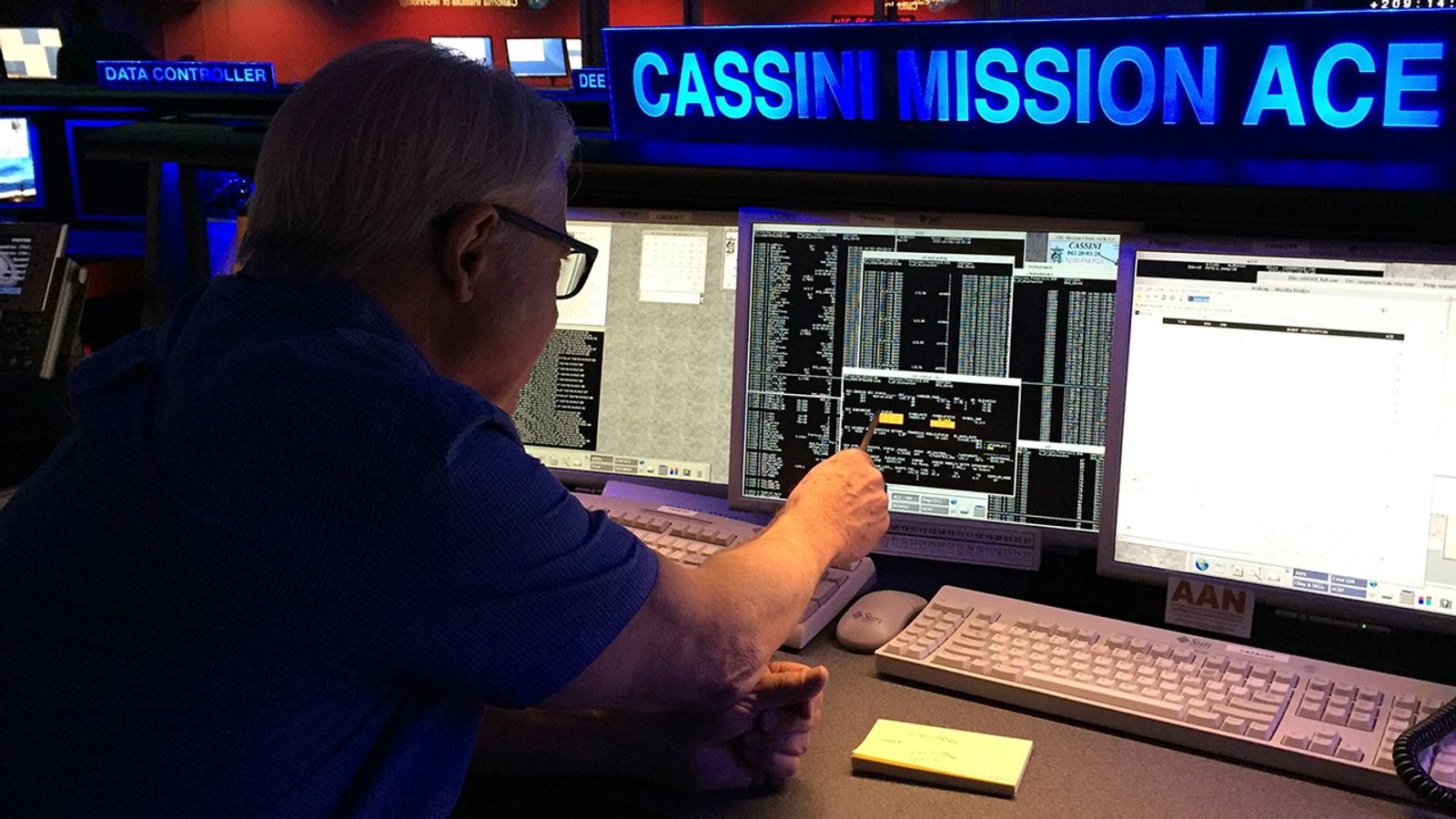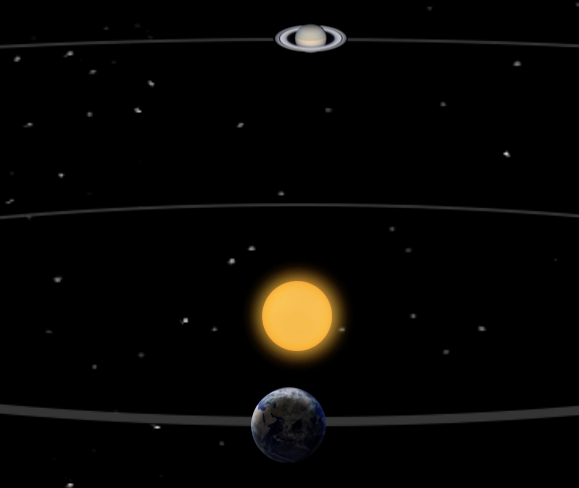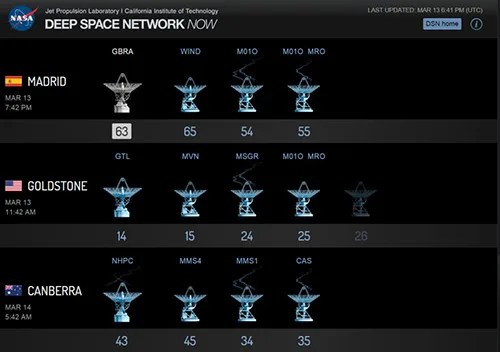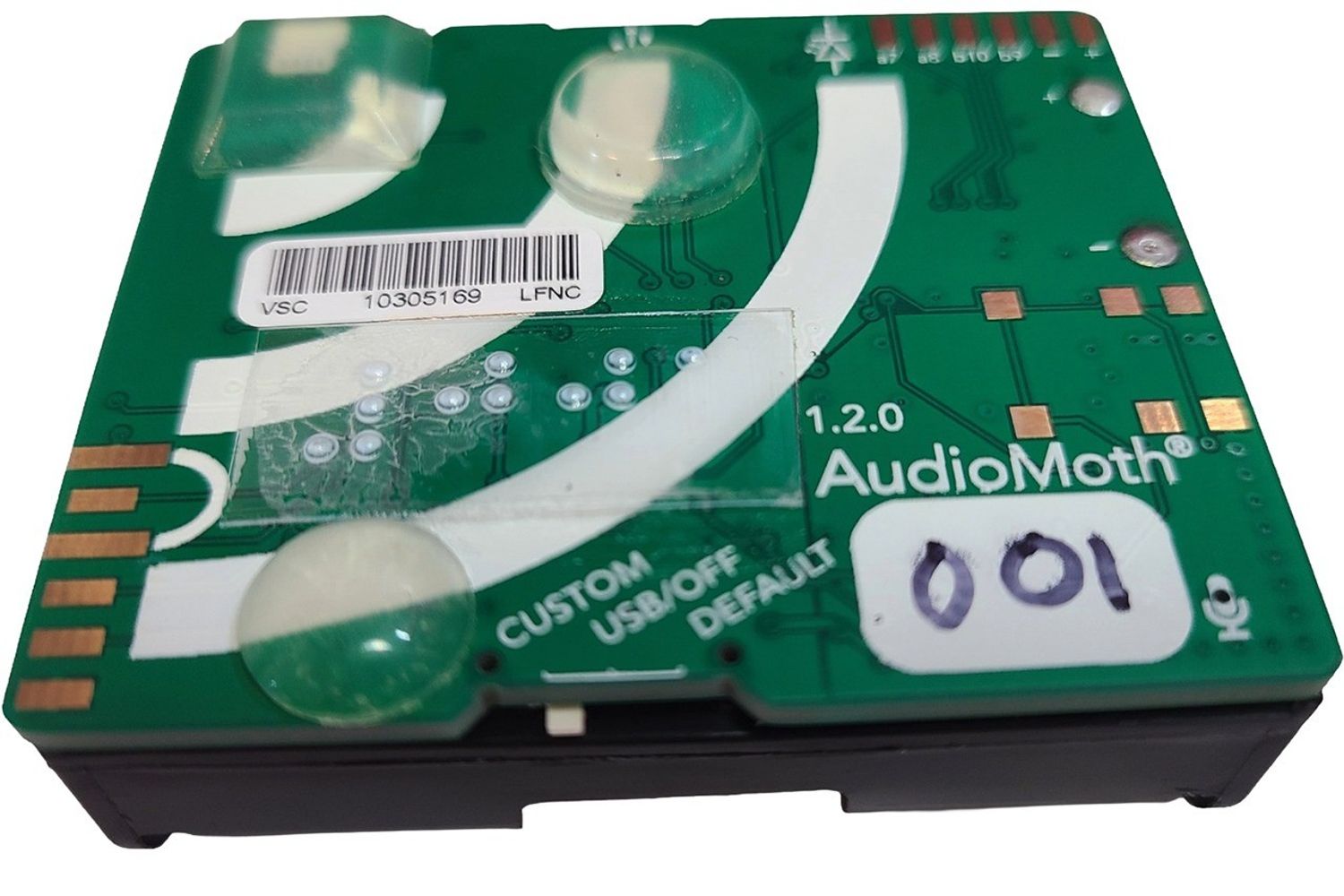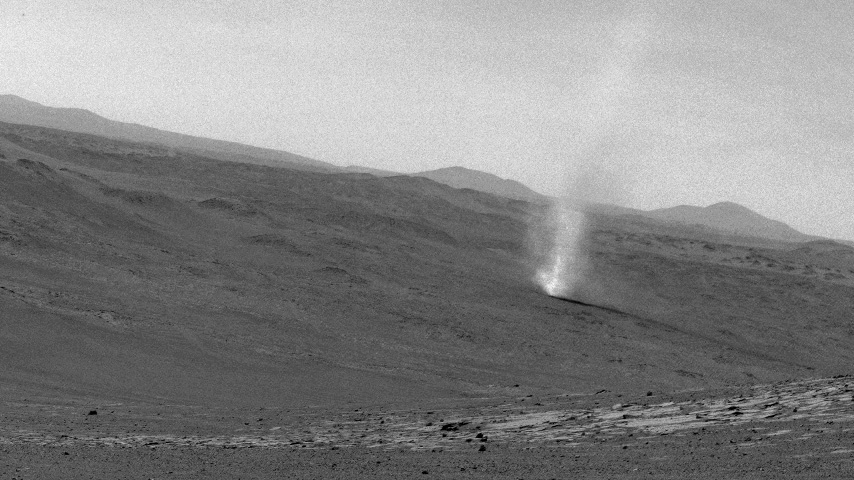Like NASA’s other spacecraft traveling beyond Earth orbit, Cassini would be unable to share its astounding discoveries with Earth if not for the Deep Space Network, a global collection of radio antennas that listen and talk to NASA’s fleet of spacecraft exploring the solar system.
From the moment humans started launching things into space, engineers have tried to make spacecraft as light and compact as possible so that rockets can heave them far from Earth. But by necessity, spacecraft must also be fully self-contained. They have their own power supply, attitude control system, science instruments, and a communications system with a radio antenna for communicating with Earth.
“They’re just little cities of engineering, all in a tiny little package,” said Dave Doody, leader of the Cassini mission’s real-time operations team at NASA’s Jet Propulsion Laboratory. “But they’re no good without thousands of tons of concrete and steel,” he said. That concrete and steel takes the form of the monstrous, dish-shaped radio antennas of NASA’s Deep Space Network (DSN).
The DSN has three sites around the globe — near Madrid, Spain; Canberra, Australia; and Goldstone, California. Each complex is approximately 120 degrees of longitude from the other two, providing the DSN with 360-degree coverage of outer space. In principle, every NASA spacecraft in the solar system and beyond always has a line of sight with some part of the DSN.
We carry out the schedules, get the data, make sure we got the data, archive it, and make sure it gets to the people who want it. But the really fun part is doing radio science experiments in real time. That’s where you turn off the commanding, you turn off the ranging, you turn off the telemetry, and you just use the radio beams as a science instrument. - David Doody, Cassini Real-Time Operations Manager
Each DSN complex has one radio antenna that measures 70 meters (230 feet) in diameter, several that measure 34 meters (112 feet) in diameter, and one antenna measuring 26 meters (85 feet) in diameter, so that each site can communicate with several spacecraft at once. The vast size of the DSN’s antennas, along with amplifiers cooled to near absolute zero, allow them to detect and collect weak radio signals, which is important because Cassini barely whispers.
Pump Up the Volume
All of Cassini’s hardware — its science instruments, propulsion system, computers, radio communication system and more — share electricity from the spacecraft’s power source, which produces about 600 watts. That’s just enough electricity to power a kitchen blender, and only part of that power can be used for communication with Earth nearly 900 million miles away.
When Cassini’s signal arrives at a DSN antenna, the signal bounces off the antenna’s collecting dish, whose shape focuses the signal up to the reflector (the thing supported by long arms of scaffolding above the dish), which in turn reflects the now concentrated signal down into a narrow opening in the center of the collecting dish. Then, in a nearby building, the signal is converted into science and engineering data.
But while Cassini and other spacecraft transmit only a weak signal to Earth, the DSN transmits to spacecraft not in a trickle, but a blast. “Normally, it’s an 18,000-watt transmission going up to the spacecraft,” Doody said. That’s in the neighborhood of the wattage of a big-city FM radio station.
Signals from powerful radio stations on Earth fade if you drive a few dozen miles from the transmitter because their signal is spread out to reach as large an audience as possible. But the antennas in the DSN have just one listener at a time, so they use their bowl-like shape to focus signals into a beam, like a spotlight. A narrow signal is stronger than one that’s spread out, but also only works well if it’s pointed the right direction, and the solar system doesn’t stand still, which presents a problem.
When the DSN communicates with Cassini, the pair have much to say. The spacecraft shares its scientific observations and its health information — status of power supply, propulsion system, software, instruments, temperatures, and so on. At the same time, the DSN relays Cassini its next assignment: which instruments to turn on and when, how long to use its engine or thrusters and in which direction, and the time and date that it should next point its high-gain antenna toward Earth for another chat with the DSN, of course.
That’s a lot of information to share, so they talk as long as they can, which is limited to about nine hours at a time, with signals traveling in both directions simultaneously. The nine-hour limit is the result of the antenna being attached to Earth’s surface and Earth rotating on its axis. From a point of view on the surface our spinning Earth, every major body in our solar system appears to move westward across the sky, just like our sun and moon. Saturn (and therefore Cassini) is no exception. Any single DSN antenna can talk to Cassini only when it has a line of sight to Saturn. In other words, from Saturn-rise to Saturn-set. To add further variables to the equation, Earth also orbits the sun and Cassini travels tens of thousands of miles per hour around Saturn.
As a consequence, a DSN antenna does not simply point at the sky and start transmitting. The dish — thousands of tons of steel — must first point its dish at a very specific spot just about the eastern horizon and then tilt up slowly, smoothly and precisely to stay locked on target as our world literally moves beneath its feet. Yet the Cassini team and the DSN teams work together and make it happen. “The 6 million pounds of steel can point to a spot in the Saturn system with such precision that it really boggles the mind,” Doody said.
In contrast to the vast distances and planetary motions involved, the DSN is analyzing something so delicately tiny that human senses could never detect it.
Cassini’s signal to the DSN arrives in the form of what Doody calls a “phase wiggle.” It takes six wiggles to make a single bit (a one or a zero in binary computer code), and Cassini sends between 33,000 and 140,000 bits per second, depending on the size of the DSN antenna scheduled to receive the signal.
Once the signals are received by Canberra, Madrid or Goldstone, the DSN sends the data on a much shorter trip around planet Earth to the scientists and engineers who are eager to receive it. “The DSN picks up these ones and zeros and puts them in a long train and sends them to us through communications satellites,” Doody said. “Thanks to error-correction and replay protocols, there’s never any data lost along the way.” That’s in case a signal is lost during satellite communications.
Once Cassini says all it has to say, the spacecraft clears its data storage to make room for the next set of scientific data. One time, however, Cassini made an exception.
Just This Once
The European Space Agency’s Huygens probe rode along with Cassini to Saturn, and separated from the spacecraft in late 2004 to descend onto the huge moon Titan. Huygens had only enough battery power to last a couple hours after landing, so it ended its mission shortly after transmitting its data to Cassini, leaving the orbiter as the only place storing Huygens' observations about Titan’s atmosphere and surface. So Cassini did not immediately wipe its memory after transmitting the Huygens data. It instead sent the precious data to Earth a second time, just to be sure. But it didn’t stop there.
Rain and other unpreventable circumstances can interrupt spacecraft communications with the DSN, and Huygens was the first and only probe to land in the outer solar system. “We really wanted that Huygens data, and we had the program running on Cassini saying ‘Don’t take anymore science data from other instruments, don’t put anything else on the recorders. We’re going to preserve that,’” Doody said. They wouldn’t let Cassini delete the Huygens data until people back on Earth were certain the DSN had provided the flight team a complete, flawless copy of the data.
“We got 16 copies and all the copies matched bit for bit,” Doody said. “And then we said ‘Okay, we got all the Huygens data perfectly. Now, Cassini, go ahead and overwrite it. Write something else on the recorder.’”
That was an unusual circumstance, and a necessary precaution. But in day-to-day spacecraft communications, the DSN is extremely reliable. “DSN performance is really, really good,” Doody said. “Generally, we get all our telemetry, and the spacecraft receives all the commands that we send to it — really excellent performance we can depend on.” Doody would know. He and his crew are the ones who actually watch it happen.
When DSN communicates with Cassini, Doody or one of the "ACEs" on his team sit in JPL’s mission control center to monitor communications with Cassini in real time. “We carry out the schedules, get the data, make sure we got the data, archive it, and make sure it gets to the people who want it,” he said. “But the really fun part is doing radio science experiments in real time. That’s where you turn off the commanding, you turn off the ranging, you turn off the telemetry, and you just use the radio beams as a science instrument.”
Cassini’s Largest Science Instrument
When one of Cassini’s instruments measures a magnetic field, or analyzes dust particles, or collects an image, the data is stored on the spacecraft for hours or days until Cassini can point its high-gain antenna at Earth to transmit the data to the DSN. However, Cassini’s Radio Science Subsystem (RSS) does things differently.
Cassini doesn’t collect data from the radio science instrument. It only transmits signals.
When Cassini sends radio signals through the atmospheres of Titan or Saturn, the signal bends. The amount of bending tells researchers a lot, including the temperature of those atmospheres, or their structure. Scientists also use radio signals to measure the sizes of ring particles and investigate the rings' structure. The instrument also has repeatedly sent a radio signal through the haze of Titan to reflect off the moon's solid and liquid surfaces. In each case, Cassini does not receive any signal back from its observation. The DSN receives the signal.
In other words, radio antennas on Earth serve as the detectors for Cassini’s radio science instrument, and that makes the DSN part of Cassini’s radio science instrument — an instrument nearly a billion million miles long.
Such experiments require an impressive level of precision. “Everything is moving,” Doody said. “Titan is whipping around Saturn, Saturn is going around the sun, Earth is moving.” And Cassini itself is moving too. “So, radio science is a really cool thing,” Doody said, given all the planning required to make the observations happen.
One of Cassini's grandest radio science experiments may reveal some of Saturn’s best kept secrets: The mass of Saturn’s rings, and the planet’s interior structure.
Anything the size of a planet has enough mass (and therefore gravity) to tug on a spacecraft that passes nearby. And if a spacecraft is transmitting a radio signal to Earth when a planet tugs on the spacecraft, the signal heard on Earth will include a Doppler shift. The size of the Doppler shift is a direct result of a planet’s gravity, which is a direct consequence of that planet’s mass and the structure of its interior. So by precisely measuring the spacecraft’s Doppler shift, scientists can determine a planet’s mass and guess at its mass distribution. Usually.
When Cassini and previous spacecraft have measured Saturn’s mass, the Doppler shift they’ve observed was actually caused by the combined mass of the planet and its rings. So while the total mass of Saturn and its rings is known, scientists don’t know the mass of the planet alone or the rings alone. Scientists also can’t tell precisely how non-spherical Saturn is.
Despite having about 750 times the volume of Earth, Saturn rotates more than twice as fast as Earth, completing a full rotation in less than 11 hours. That spin affects Saturn’s shape, according to Luciano Iess, a radio scientist at Sapienza University of Rome. “Saturn is fatter at the equator,” he said. “We know that Saturn is oblate due to the fast rotation, but the rings do not allow a precise measurement of that oblateness.” But then, Cassini isn’t done yet.
In its final adventure, Cassini passes between Saturn and the inner edge of its rings. No spacecraft before has explored that region of space. Yet Cassini will perform the feat 22 times starting in April 2017. With the rings to one side and the planet on the other, Cassini will give scientists their first chance to measure Saturn’s mass, separate from that of its rings. It will also allow scientists to more precisely measure how “fat” Saturn is. “This is very important for determining the interior structure of Saturn,” Iess said.
And it will have been made possible, in large part, by the largest, most distant component of the Cassini mission, NASA’s Deep Space Network.
Learn more about the basics of spaceflight.
Conjunction Junction
What do you do when the sun comes between you and your spacecraft? On Cassini, it's a chance to experiment with our largest science instrument.
The Deep Space Network
When it comes to making a long-distance call, it's hard to top NASA's Deep Space Network. It’s the largest and most sensitive scientific telecommunications system in the world.
Deep Space Network Now
Enter the intricate world of NASA’s Deep Space Network as we provide you an inside look at how our team communicates and tracks multiple spacecraft within the solar system 24 hours a day, 7 days a week, 365 days a year. This real-time data is updated every 5 seconds and will allow you to examine how quickly the data is being received, how long a signal takes to and from each spacecraft and the current state of the entire network.





























